Let’s be honest; the biggest difference between a paddleboard and a kayak is whether or not you want to spend the day standing up or sitting down. Of course, there are seat modifications for a stand-up board, but, for the most part, you’re standing while you paddle.
To make an accurate comparison, it’s important to touch on the similarities as well. Both kayaks and stand-up paddle boards belong on the water. That goes without saying. If you enjoy cliff diving, a SUP or a kayak is not for you.
I suppose you could dive off a cliff on a SUP or a fishing kayak if that’s your thing, as long as you bring along a good parachute. Both crafts are manufactured for various activities, including paddleboard fishing, whitewater rafting, recreational cruising, and exercise (depending on the brand and model), and both are relatively simple to use.
The good news is, you can basically kayak in both (if you install a seat for a kayak on a SUP), but you can’t stand up paddleboard in a kayak.
Is It Easier to Kayak or Paddle Board?
Paddling on a SUP is not more difficult than kayaking unless the conditions on the water are rough. The paddles are very similar for both crafts in terms of length (kayaks use a double-bladed paddle), but it’s harder to maintain a standing position, balance, and paddle, especially over long distances, in rough water.
In choppy waters or when that giant wake rolls in (thanks to a hapless boater who ignores the rules for creating wakes in a channel), it’s far safer to be seated in a kayak. This is true even if you install a seat on your SUP.
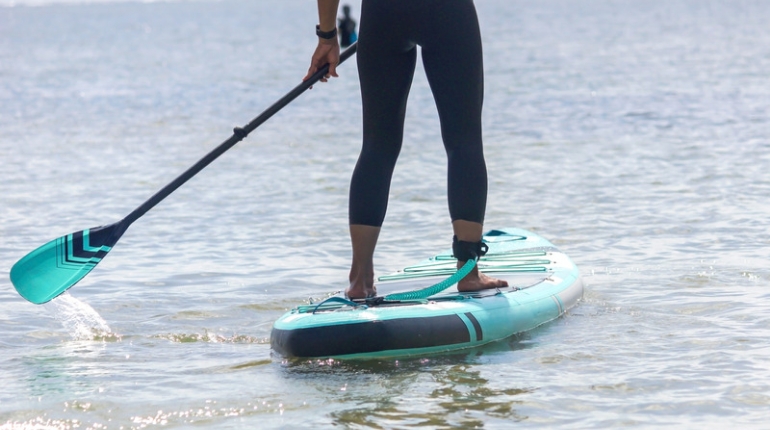
The hull designs on kayaks are designed for cutting through the water, even if it’s a recreational kayak. The hull on a SUP is entirely different, lacking that slicing effect you need when encountering big waves.
That doesn’t mean that an experienced paddle boarder can’t navigate heavy waves. It only means that it requires a great deal more experience and know-how when paddle boarding.
What Burns More Calories: Kayaking or Paddle Boarding?
Both kayaks and SUPs are known as “low-impact” exercises. A 150 lb person will burn about 340 to 350 calories per hour kayaking. That’s assuming the person in question is paddling non-stop, with few variables, for 60 minutes. Using a SUP, assuming everything is the same, burns between 350 to 450 calories per hour.
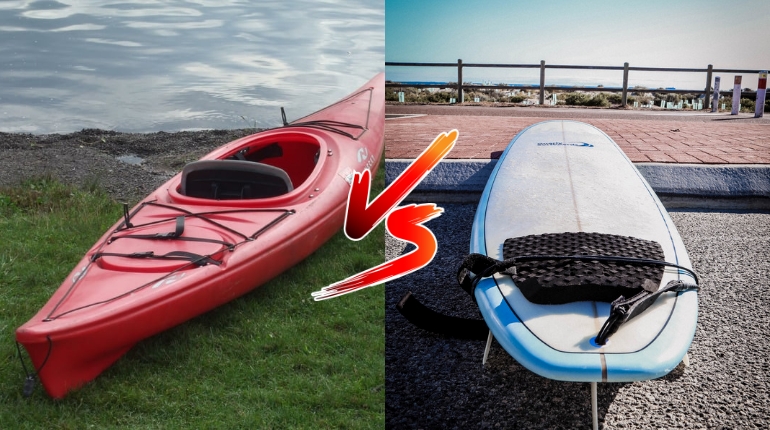
If you’re on the SUP in heavy surf, the number of calories burned jumps to around 600 calories per hour. But you could say the same about whitewater kayaking. Obviously, kayak fishing and SUP fishing aren’t going to burn much unless you’re actively fighting a fish.
The thing is, there are so many intangibles or variables, if you will that coming up with a specific, mathematically accurate assessment of calories burned when paddle boarding or kayaking is difficult, to say the least.
One thing is for sure; it’s a low-impact exercise that builds your lower and upper body strength and is often considered more beneficial than running or jogging.
Since using a SUP board requires standing, it’s “generally” thought of as more intensive than sit-down kayaking. Most kayaks are recreational, but many are designed for more dynamic circumstances, like kayaking in rough, fast-moving currents or speed kayaking.
When you’re actively engaging in those activities, the differences between SUP and Kayak activities become negligible at best.
Paddle Board Vs Kayak: Which Should You Buy?
If you’re looking for nothing more than a fun way to get in an upper body workout, it’s hard to say which is better. A standup paddleboard does a little better when it comes to a whole-body workout but kayaks offer the option of sitting down when you want.
I can throw some comparisons your way and some of them will sound very convincing, mostly because they are. But, at the end of the day, it really boils down to personal preference.
Stability
It might surprise you to know that SUPs are more stable than kayaks, at least in general terms. This is because a stand-up paddleboard has a wider hull and is slightly curved upward at the bow. Most paddleboards feature this simple design, also known as a planing board design.
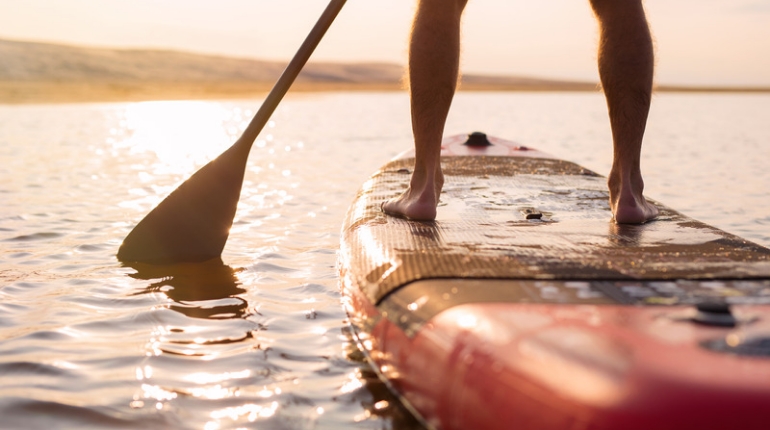
When I was a child, I loved to skip rocks, and only the flattest rocks would do. The more the rock resembled a flying saucer, the better it would skim across the water multiple times. The concept with SUPs is the same. This design makes it possible to stand up on the paddleboard with relative ease.
It doesn’t matter if it’s a standard paddleboard or an inflatable standup paddle board. Kayaks usually feature what is known as a displacement hull. Displacement is the name of the game when you want to move through the water quickly.
However, it is not as stable as the planing board design. It does make kayaks faster. Inflatable kayaks feature this design as well, though inflatable designs are generally focused on stable recreational kayaks.
Learning Curve
The paddleboard vs kayak debate almost always revolves around the learning curve. Despite the stability superiority of SUPs, it’s often more difficult to stand up paddleboard from a mental perspective. It’s like skateboarding versus riding a bike.
The bike just looks easier to learn; therefore, it’s easy to adopt a specific mental attitude. At the recreational level, kayaking is probably a little easier to learn but only by a very slim margin.
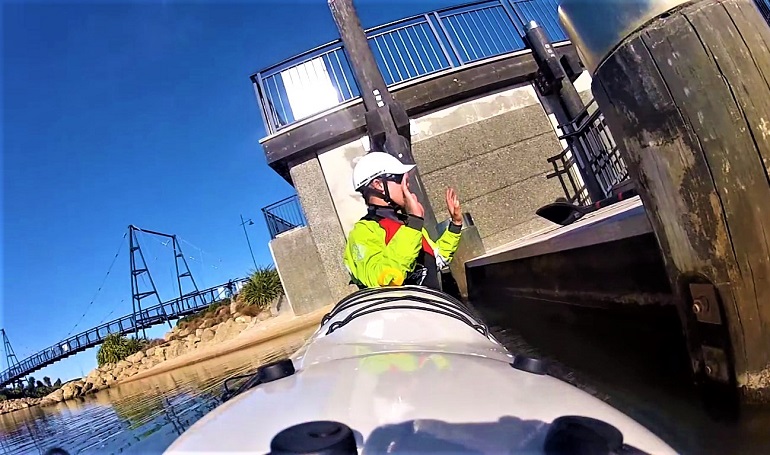
While standard recreational kayaks sell better right now, inflatable kayaks are quickly becoming all the rage, especially since they are easy to learn. Another similarity with the paddleboard vs kayak debate is paddling. Paddling is fairly simple in both.
SUPs use a long paddle, just like kayaks, but they only have a blade on one end. Kayaks feature double-bladed paddles. The biggest learning curve with both is to push with your upper arm rather than pull with your lower arm.
Portaging
Paddleboard vs kayak portaging is barely worth debating. I’ve carried both and used the various carts and racks designed for both. SUPs are the clear winner.
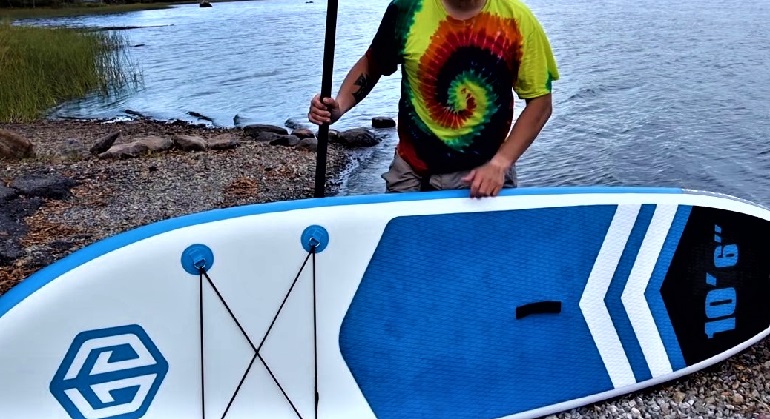
Most paddleboards weigh about 30 lbs, and they’re flat and streamlined. Kayaks are bulkier, weigh 35+ lbs, and are often longer, especially if you have a comfortable tandem kayak.
A paddleboard may swing around and slap you in windy conditions, but they are generally easier to haul around than kayaks. Both inflatable kayaks and inflatable stand-up paddleboards are easier to carry around in a convenient carrying bag, but an inflatable kayak is still heavier more often than not.
Durability
When it comes to good kayak brands with established reputations, both kayaking and paddle boarding provides greater stability and durability than ever before. But there can be only one winner in the paddleboard vs kayak conversation, and kayaks are the superior craft in terms of durability.
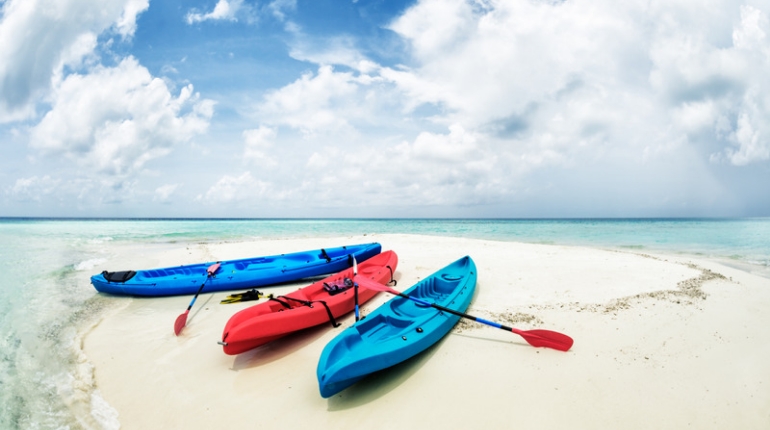
The biggest concern I run into (as most kayakers do) is running my kayak over rocks, sand, or even concrete. It’s hard to help it when you’re in shallow water or swinging around at the launch. Of all the things that damage kayaks over time, it’s abrasions on the hull.
When it comes to SUPs, it’s just a matter of design, and they don’t last nearly as long (assuming you or I would take very good care of the SUP or kayak).
A well-taken-care SUP will slowly degrade over time, with the stitching coming loose and the material wearing thin. On the other hand, a well-taken care-of kayak will last a lifetime if you can just keep it off those pesky rocks. Anglers tend to get the most out of their SUPs and kayaks.
Whether they’re SUP fishing or fishing from a kayak, they tend not to use and abuse their crafts as much as everyone else. Catching bass just isn’t the same as battling a raging river, cruising downstream faster than a speed bike running downhill.
On Board Storage
When it comes to onboard storage, the kayak wins again. You can carry gear on a paddleboard, but it has to be perfectly centered, and you just can’t take much of it along for the ride. Kayaks are designed to carry more, often including multiple storage compartments for a wide variety of gear and tools.
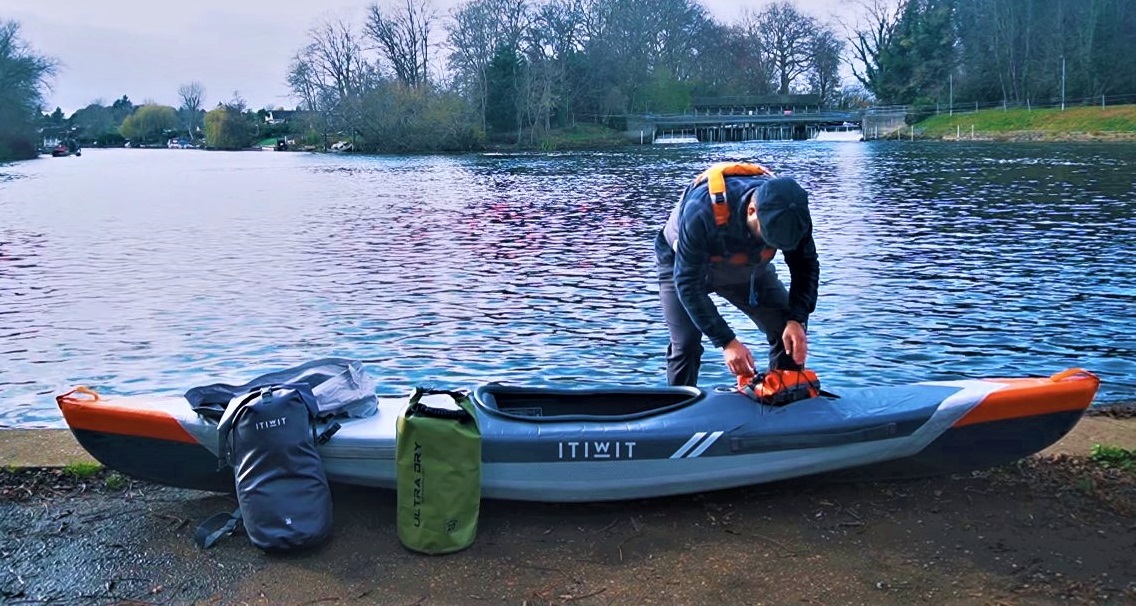
Paddleboard vs kayak storage space is like comparing buckets vs plates. Rod holders are something you often have to add to SUPs, but kayaks feature rod holders as part of their design.
Kayaks have more storage options, carry more gear, and even feature storage options for the best dry bag for paddle boarding to keep your gear dry. There is no comparison here.
Storage on Land
When it comes to storing a kayak or a SUP, the comparison is flipped, with SUPs having a clear advantage and for obvious reasons. Stand-up paddleboards are flat and often not as long as kayaks. Though they use the same J-hooks and car roof rack storage, it’s easier to hold more SUPs without sacrificing much space.
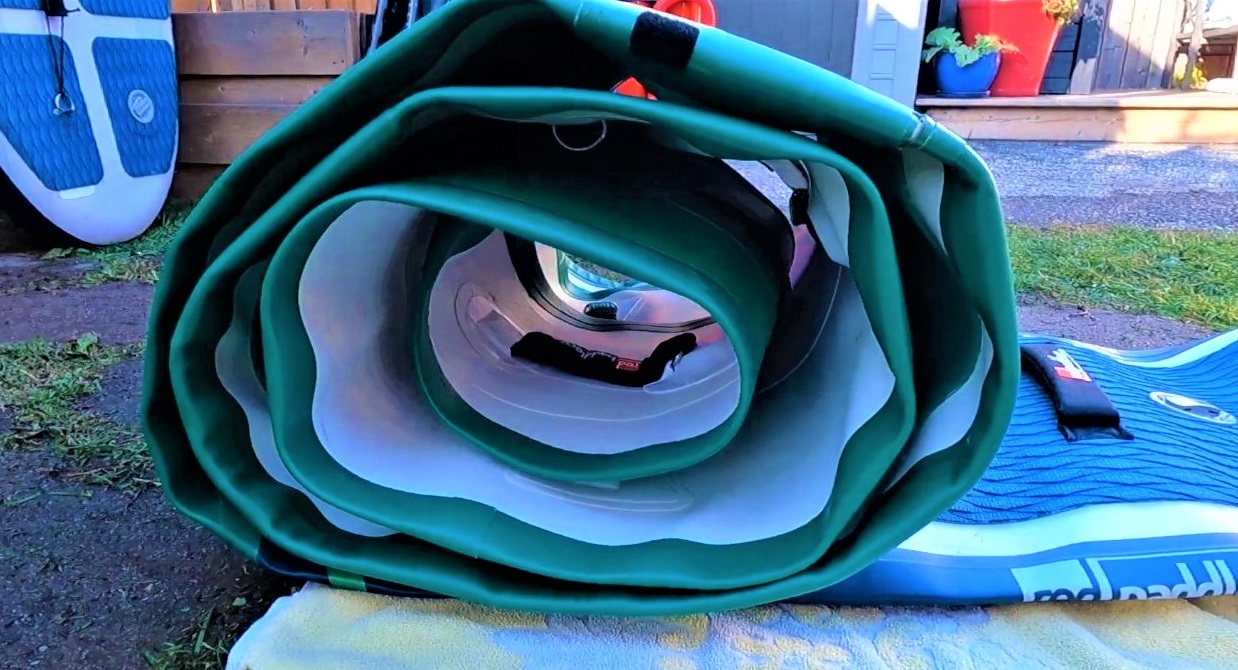
Kayaks are bulky, especially sit-in kayaks, and take up more space, regardless of where you choose to store them. A kayak is more likely to be right in the way if you store it in the garage. Tie-downs and other accessories just take up even more space.
Long Distance Paddling
Depending on your paddling experience, long-distance paddling will become more prevalent throughout your time on the water. Long-distance touring SUPs are popular, as are touring kayaks.
Ultimately, a long-distance paddle board vs kayak boils down to what you like and prefer. However, a kayak is better equipped for the long run, with more storage capacity and a hull design that’s faster in the water.
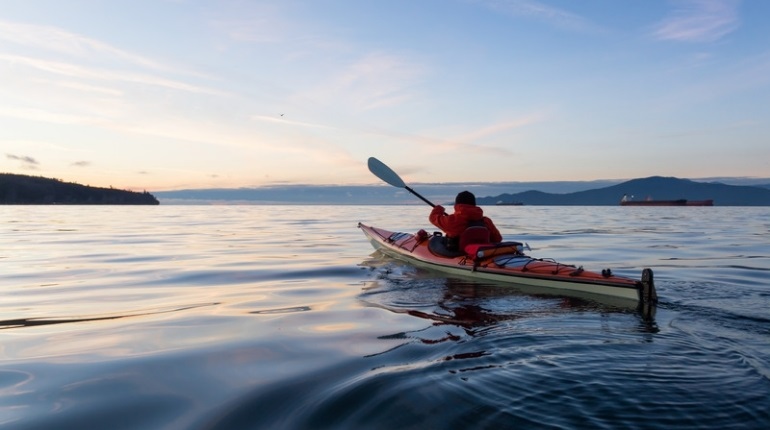
There are notable differences between cold-weather paddling and warm-weather paddling. It’s just a lot more fun to hit the warm water with paddleboards than kayaks, and the fun factor has a lot to do with how far you have the desire to paddle.
For traveling downstream with the whole family, kayaks are the best choice beyond a doubt. However, for a solo journey, especially when it’s competitive, a touring SUP trumps kayaks all day long.
A kayak paddle probably works your body more, but the sitting position makes all the difference throughout long periods on the water.
Sightseeing
Sightseeing with a paddleboard vs kayak really makes no difference. For seafaring voyages, a kayak holds the edge just in terms of comfort out on the open water. Fortunately, exploring and sightseeing down a river, in a lake, or along any shoreline is a lot of fun in either craft.
The only advantage a standup paddleboard might have is the ability to get in really close to the shoreline and access areas where a kayak hull would scrape the bottom. The double-bladed paddle is far more efficient in a kayak, especially when it comes to pushing off in closed-in areas.
Kayak paddling is easier when accessing areas where the tree limbs hang low, or shoreline brush is an obstacle. For the most part, however, it doesn’t really matter which craft you choose to sightsee in. Both will take you almost anywhere you want to go.
Fitness
There’s no doubt that a kayak is a fantastic fitness vessel, whether you are actively using it for that or not. Paddleboards just have too much versatility for any kayak type to compete. With paddleboards, people can sit, stand, practice SUP yoga, and even do squats to work the leg muscles while maintaining balance.
Of course, you could always pick up a kayak with paddles. While that would make a substantial difference with your lower body, your upper body loses out when all you need a kayak paddle for is to change directions.
With paddleboards, a full-body workout isn’t out of the question. You could probably get a full-body workout in a kayak, but you might look a little silly trying to do it.
Paddleboard vs kayak workouts are automatic every time you hit the water, but a true workout is easier to obtain on paddleboards, especially if you prefer working your entire body. Speaking of “entire body,” yoga certainly fits the definition, and you will find that rolling over backward is much harder in a kayak than it is in a SUP.
Can You Use a Paddleboard as a Kayak?
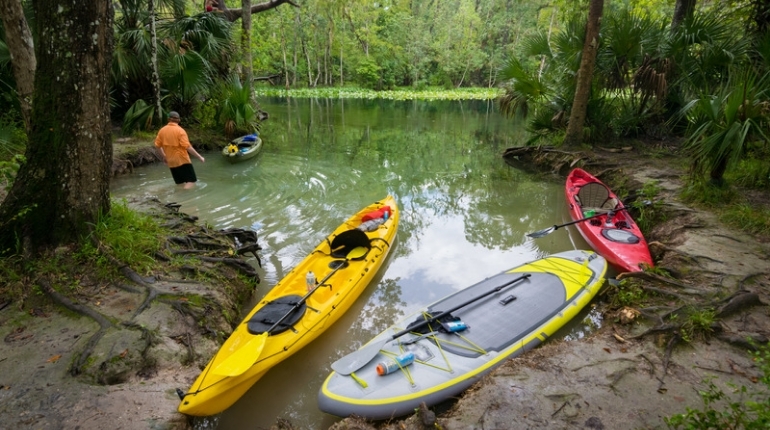
This is one advantage paddleboards have over a kayak. You can turn paddleboards into kayaks, but it doesn’t work the other way around. Even an inflatable SUP can convert into a kayak setup.
While there are seat kits specifically designed for paddleboards, almost any kayaking seat will do the trick. It won’t even take a little practice first because the setup is so simple.
This is where the versatility of a SUP shines. You can ditch the SUP paddle and pick up a kayak paddle while never needing the kayak. While a SUP will never be able to take on the number of things a kayak can do, it’s surprisingly capable, so long as you keep things centered and balanced.
There are several things you can add to a paddleboard to make it more kayak-like, both in terms of how it performs in the water and what it’s capable of.
- The addition of a kayak seat
- Drift chute for slow approaches
- Add-on rod holders
- Outrigger for improved stability
Outriggers sort of defeat the purpose of a SUP, but they are removable for the days when you want more maneuverability, balance, and freedom.
How to Convert Your Sup into a Kayak
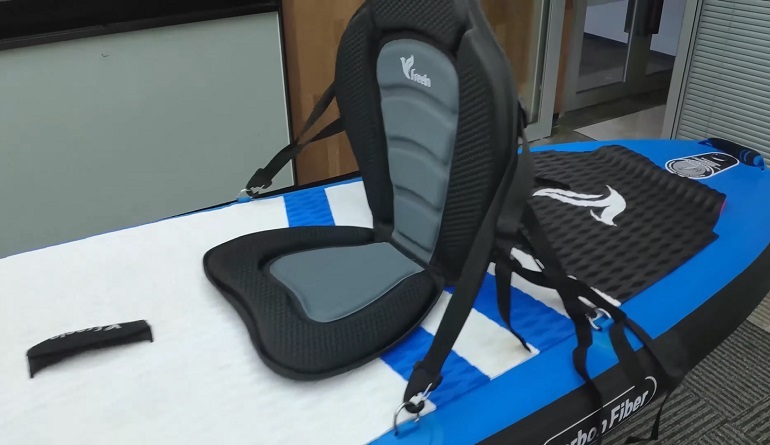
I’ve done quite a few this way, especially when taking the kids out or going fishing. Fishing gear is so much simpler to haul around when you’re in a seated position. A conversion also opens up a range of new and interesting possibilities, such as hitting up a white water excursion.
While there are some who have proven that SUPs are capable as a white water option, they just aren’t as safe and stable as a SUP with a seat conversion thrown in. Here is how you can convert a SUP into a kayak:
- Make sure the kayak seat is centered
- Attach the front straps to the front D-rings and do the same with the back D-rings
- Double-check to make sure the seat is centered
- Tighten the straps while maintaining the seat in its position
Keeping the seat straps tight and maintaining the seat in its center position offers more stability. Most beginners jumping on paddleboards for the first time will love the added versatility of a seat you can easily install or remove at will.
Sup Fishing Vs. Kayak Fishing: What to Know?
The difference between paddleboard fishing and fishing from a kayak is pretty extensive, and kayaks hold most of the advantages. That’s not to say that paddleboards are no good for fishing because they certainly are. I’ve fished from both, and kayaks are by far my go-to choice because of their several advantages.
- Angler-focused kayak prices are better than SUPs.
- Kayaks are more stable with a lower center of gravity
- Its a bit easier to fight a fish from a kayak
- Kayaks have more storage and often have live wells
- Some kayaks feature paddles
- Its easier to mount fish finders and add fishing kit to a kayak
- It’s quite a bit easier to fight a fish while braced and sitting than standing on a small, open deck
You have a better vantage point when standing up, so a good SUP has that advantage. However, only a very skilled angler can hook and fight a big fish when the tiniest shift of your feet will send you and the SUP spinning.
It’s one thing to balance while moving your feet on a SUP. It’s quite another to do so while a fish is pulling hard and swimming laterally. But look, I make up just one man’s opinion. No one will ever convince me that fighting a monster bass over frigid water on a SUP is somehow in my best interests.
But that’s just me. Most people prefer to go their own way and if battling the intricacies of balance and a fish that’s going bananas under your SUP happens to be your thing, so be it.
For what it’s worth, the aforementioned outriggers make more sense when fishing from a SUP. You also have the option of adding kayak outriggers, though it doesn’t improve the balance as much as it does in a SUP.
Which Is Better: Kayak or Paddleboarding?
Why not both? You’ll have so much fun on either that it’s hard to imagine only choosing one over the other. However, if you absolutely have to choose, you’ll get the standard answer from me: it all boils down to personal preference.
You wouldn’t buy a kayak if you wanted to do yoga on the water, would you? There’s a tool for every task, as the saying goes, and if paddle board fishing is your thing, then you don’t have any business purchasing a john boat to bring your dream to life.
Kayaks are usually the most popular option if you have a family with a couple of kids. This is especially true if you enjoy a full-day trip or even a multi-day adventure. Year-round warmer climates trend towards SUPs.
There’s something about being out in the full sun, standing or sitting, and enjoying life out on the water with a good SUP. Shallow waters favor SUPs as well.
Whether you’re an angler trying to get close to some shallow vegetation or an explorer, you can push a SUP farther inland than you can a kayak, especially if it’s a sit-inside kayak with a deep hull.
Rough waters with plenty of chops, raging rivers, and high winds favor kayaks, while flat water, yoga, and good exercise, like an isolated workout, favor SUPs (especially yoga). If a great workout and building your core strength are your goals, you will get it from both, but more so with SUPs.
Conclusion
Not everyone will share the same position, but one vessel just seems like too few to me. If you enjoy the things that SUPs and kayaks offer, you should strongly consider both. Your fitness level will improve either way, and there are so many ways to take advantage of either.
You may end up with a little less room in the garage, but you’ll have a SUP for those sunny, gorgeous days and a kayak when strong winds are prevalent, and you need some grab handles. Either way, you’ll have a blast on the water, even if you come up short on a fishing day or two.
After learning about the difference between kayaks and paddleboards, you might want to look into an oar vs. paddle comparison to get better informed about what gear you should choose.
0 Comments